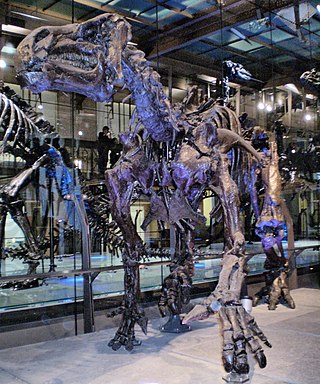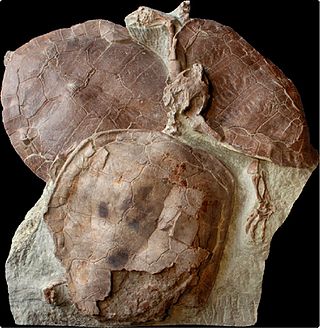
Iguanodon, named in 1825, is a genus of iguanodontian dinosaur. While many species found worldwide have been classified in the genus Iguanodon, dating from the Late Jurassic to Early Cretaceous, taxonomic revision in the early 21st century has defined Iguanodon to be based on one well-substantiated species: I. bernissartensis, which lived during the Barremian to early Aptian ages of the Early Cretaceous in Belgium, Germany, England, and Spain, between about 126 and 122 million years ago. Iguanodon was a large, bulky herbivore, measuring up to 9–11 metres (30–36 ft) in length and 4.5 metric tons in body mass. Distinctive features include large thumb spikes, which were possibly used for defense against predators, combined with long prehensile fifth fingers able to forage for food.

Hypsilophodon is a neornithischian dinosaur genus from the Early Cretaceous period of England. It has traditionally been considered an early member of the group Ornithopoda, but recent research has put this into question.

Baryonyx is a genus of theropod dinosaur which lived in the Barremian stage of the Early Cretaceous period, about 130–125 million years ago. The first skeleton was discovered in 1983 in the Smokejack Clay Pit, of Surrey, England, in sediments of the Weald Clay Formation, and became the holotype specimen of Baryonyx walkeri, named by palaeontologists Alan J. Charig and Angela C. Milner in 1986. The generic name, Baryonyx, means "heavy claw" and alludes to the animal's very large claw on the first finger; the specific name, walkeri, refers to its discoverer, amateur fossil collector William J. Walker. The holotype specimen is one of the most complete theropod skeletons from the UK, and its discovery attracted media attention. Specimens later discovered in other parts of the United Kingdom and Iberia have also been assigned to the genus, though many have since been moved to new genera.
The Isle of Wight is one of the richest dinosaur localities in Europe, with over 20 species of dinosaur having been recognised from the early Cretaceous Period, some of which were first identified on the island, as well as the contemporary non-dinosaurian species of crocodile, turtle and pterosaur.

Valdosaurus is a genus of bipedal herbivorous iguanodont ornithopod dinosaur found on the Isle of Wight and elsewhere in England, Spain and possibly also Romania. It lived during the Early Cretaceous.

Weald Clay or the Weald Clay Formation is a Lower Cretaceous sedimentary rock unit underlying areas of South East England, between the North and South Downs, in an area called the Weald Basin. It is the uppermost unit of the Wealden Group of rocks within the Weald Basin, and the upper portion of the unit is equivalent in age to the exposed portion of the Wessex Formation on the Isle of Wight. It predominantly consists of thinly bedded mudstone. The un-weathered form is blue/grey, and the yellow/orange is the weathered form, it is used in brickmaking.

Polacanthus, deriving its name from the Ancient Greek polys-/πολύς- "many" and akantha/ἄκανθα "thorn" or "prickle", is an early armoured, spiked, plant-eating ankylosaurian dinosaur from the early Cretaceous period of England.

Nuthetes is the name given to a genus of coelurosaurian theropod dinosaur, either a dromaeosaurid or a tyrannosauroid, known only from fossil teeth and jaw fragments found in rocks of the middle Berriasian age in the Cherty Freshwater Member of the Lulworth Formation in England and also the Angeac-Charente bonebed in France. If it was a dromaeosaurid, Nuthetes would have been a small predator.

Mantellisaurus is a genus of iguanodontian dinosaur that lived in the Barremian and early Aptian ages of the Early Cretaceous Period of Europe. Its remains are known from Belgium (Bernissart), England, Spain and Germany. The type and only species is M. atherfieldensis. Formerly known as Iguanodon atherfieldensis, the new genus Mantellisaurus was erected for the species by Gregory Paul in 2007. According to Paul, Mantellisaurus was more lightly built than Iguanodon and more closely related to Ouranosaurus, making Iguanodon in its traditional sense paraphyletic. It is known from many complete and almost complete skeletons. The genus name honours Gideon Mantell, the discoverer of Iguanodon.

The Wessex Formation is a fossil-rich English geological formation that dates from the Berriasian to Barremian stages of the Early Cretaceous. It forms part of the Wealden Group and underlies the younger Vectis Formation and overlies the Durlston Formation. The dominant lithology of this unit is mudstone with some interbedded sandstones. It is part of the strata of the Wessex Basin, exposed in both the Isle of Purbeck and the Isle of Wight. While the Purbeck sections are largely barren of vertebrate remains, the Isle of Wight sections are well known for producing the richest and most diverse fauna in Early Cretaceous Europe.

Cearachelys is an extinct genus of pleurodiran turtle which existed some 110 million years ago. The genus is monotypic, with only type species Cearachelys placidoi known.

Archaeoniscus is a genus of prehistoric isopods that first appeared during the Bajocian stage of the Middle Jurassic. It is a widespread genus with a paleogeographic distribution encompassing the continental margin environments of the central Atlantic Ocean and the western Tethys Ocean. Fossils of Archaeoniscus suggest that this genus lived in diverse aquatic habitats, including the marine, paralic, and freshwater environments. While earlier descriptions suggested that it may have had an ectoparasitic association with fishes, some researchers argue that at least two species, A. aranguthyorum and A. coreaensis, lived a benthic free-living lifestyle based on morphological characteristics that are either unsuitable for or unrelated to parasitic behavior.

Pleurosternon is an extinct genus of freshwater pleurosternid turtle from the latest Jurassic to earliest Cretaceous of Europe. Its type species, P. bullockii was described by the paleontologist Richard Owen in 1853. Since then, and throughout the late 19th century, many fossil turtles were incorrectly assigned to this genus, though only two are currently considered valid.
Anteophthalmosuchus is an extinct genus of goniopholidid mesoeucrocodylian from the Early Cretaceous of southern England, eastern Spain, and western Belgium.

Adocus is an extinct genus of aquatic turtles belonging to the family Adocidae.
Denazinemys was a genus of baenid turtle that lived in the Late Cretaceous of New Mexico. The holotype specimen, which D. nodosa was based on, USNM 8345, consists of a partial carapace and plastron. It came from the De-na-zin Member of the Kirtland Formation, and therefore, Denazinemys lived in the Kirtlandian land-vertebrate age. Many specimens other than the holotype have been assigned to Denazinemys.

Xinjiangchelyidae is an extinct family of turtles known from the Lower Jurassic to the Middle Cretaceous of Asia and western Europe. They have generally been interpreted as either being basal cryptodires or placed outside of crown Testudines.

Ornithocheiromorpha is a group of pterosaurs within the suborder Pterodactyloidea. Fossil remains of this group date back from the Early to Late Cretaceous periods, around 140 to 92.5 million years ago. Ornithocheiromorphs were discovered worldwide except Antarctica, though most genera were recovered in Europe, Asia and South America. They were the most diverse and successful pterosaurs during the Early Cretaceous, but throughout the Late Cretaceous they were replaced by pteranodontians and azhdarchoids. The Ornithocheiromorpha was defined in 2014 by Andres and colleagues, and they made Ornithocheiromorpha the most inclusive clade containing Ornithocheirus, but not Pteranodon.

Basilemys is a large, terrestrial nanhsiungchelyid turtle from the Upper Cretaceous of North and Central America. Basilemys has been found in rocks dating to the Campanian and Maastrichtian subdivisions of the Late Cretaceous and is considered to be the largest terrestrial turtle of its time. In an analysis made by Sukhanov et al. on a nansiunghelyid turtle from the Upper Cretaceous of Mongolia, it was demonstrated that Asian nanhsiungchelyids gave rise to the North American nanhsiungchelyids.

Garumbatitan is an extinct genus of somphospondylan sauropod dinosaur from the Cretaceous Arcillas de Morella Formation of Spain. The genus contains a single species, G. morellensis, known from multiple partial skeletons.



















